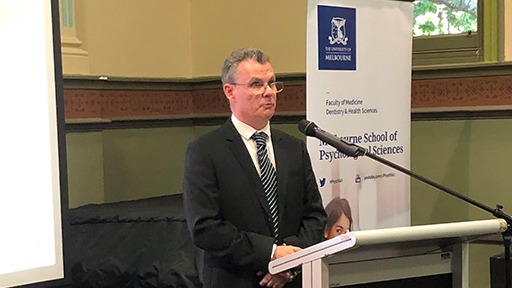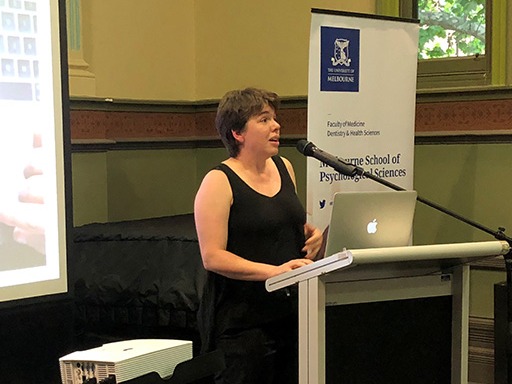We have liftoff
The launch of the Complex Human Data Hub was a great success. I would like to thank everyone involved for the effort they put into the event. In particular, I would like to thank Cameron Fletcher and Aftab Hussain for their work organizing the venue and catering, and again to Cameron for the slide show. Professor Nick Haslam and Professor Sarah Wilson's guidance in the planning stages was also very helpful. I would also like to thank the Vice Chancellor and Dean Kapur for their insightful comments.
Simon's Remarks
My name is Simon Dennis, and I’m the Director of the Complex Human Data Hub. I would like to start with the acknowledgement of country:
Today we meet on Wurundjeri lands
The Wurundjeri are members of the Kulin nation.
We acknowledge their stewardship of this place and the debt it incurs upon us
And we sincerely thank the elders - past, present and future.
Vice Chancellor, Professor Glyn Davis
Dean of the Faculty of Medicine, Dentistry and Health Sciences, Professor Shitij Kapur
Head of Melbourne School of Psychological Sciences, Professor Sarah Wilson,
Dean of the Melbourne School of Engineering, Professor Graham Schaffer
Deputy Director of the Complex Human Data Hub, Associate Professor Amy Perfors
Distinguished Guests, Ladies and Gentlemen,
I would like to welcome you all to the opening of the Complex Human Data Hub.
The hub was brainchild of Professor Philip Smith, Emeritus Professor Garry Robins and Professor Yoshi Kashima. What they realized is that we are at a unique juncture in the development of psychological science. As I have said before:
There has never been a better time to be a psychological scientist
For the first time, through the use of smartphones, wearable devices, social media and the Internet of Things, we are able to collect really dense naturalistic data sets about the behaviour of people as they engage in their daily lives.
My own work in human memory provides a paradigmatic example. We have known since Ebbinghaus that the memories that people acquire before they enter the laboratory impact dramatically the behaviour we observe. The problem has always been how to measure that experience. If you see people walking around campus with smartphones around their necks, there is a pretty good chance they are participating in one of our experiments. They are taking pictures, so don’t forget to smile. After a delay we show them the images they collect and ask when they were taken. Using a range of data sources, our models reconstruct the experience of the participants and predict the errors they will make. This is a quantum leap in the state of the art, and I believe will allow us to construct a more comprehensive, ecologically valid and translationally relevant memory science.
With its long history of excellence in mathematical psychology, the University of Melbourne is particularly well placed to take advantage of these new technologies. Big data requires equally big models - models that are motivated and informed by psychological science. The hub builds on that foundation.
The other key element of the vision set out by Philip, Garry and Yoshi is to integrate models of behaviour across multiple levels - the individual, the group and the society. Today analysis is nearly always confined to a single level. Its self evident that to really understand human behaviour in the wild, you are going to have to build models that span these levels. The long tradition of social network analysis led by Garry and formally by Pip Patterson makes us uniquely situated.
Human behaviour is at the heart of the grand challenges of our time - whether it is global warming, terrorism or the provision of health services. If we are going to meet these challenges, psychological science has to leave its adolescence behind it. I think we now have the tools to do it.
So, that is the vision. I’m so excited to be here and to be leading this initiative and I would like to reach out all those within and beyond the university who are interested in quantitative approaches to human behaviour. We are situated in psychology, but the challenges we wish to address transcend disciplinary boundaries, and we look forward to collaborating broadly.
Next up I would like to introduce Associate Professor Amy Perfors, who is the Deputy Director of the Hub.
Amy's remarks
Thank you. Like Simon, I’m thrilled to be here and thrilled that this is happening, mainly thanks to the efforts of those who came before us.
One of the reasons we’re so excited about this hub is that it represents a step towards being able to ask -- and answer -- the kinds of questions we’ve never been able to address before, at least at the same level of precision and rigour.
What kinds of questions? The ones on the slides over there give you some taste of the breadth of possibilities, but I thought I’d elaborate on just a few of them to give you a better sense of how the kind of “big data” and “big models” that Simon talked about can really add to our understanding of people and our world.
One of them is: how do people learn words and categories? This isn’t as trivial as it seems: humans -- even very little children -- are better at this than even the best AI: all we need is one or two examples and we immediately know a lot about what that word means, how it relates to other words, and when you can use it. This question has been studied for ages, but research has been pretty limited because it’s mostly been tested on people learning artificial categories in the lab. With rich mobile data, we suddenly have a much better sense of what structure real-world categories have and what kind of language input people get. We can test different models of learning on that input -- Bayesian ones with different priors and hypothesis spaces, exemplar models that are basically kernel density estimators, and others -- to understand how exactly the brain can figure out so much from so little. We’ve already used data from millions of people playing a word association game to built a huge “map” of our full mental lexicon in a variety of languages, and we can use this in combination with these other kinds of models and data to understand how the environment supports learning, and how learning and representations change over time and across languages.
Here’s another example: many researchers in the hub are interested not just in individual people but also how we interact with each other -- how we decide who to trust, how we decide to pass information along, and how the cumulative effect of all of those decisions shapes how our societies and cultures evolve. These aren’t new questions, but it’s becoming increasingly possible to use techniques from statistical physics, machine learning, and mathematics -- things like tensor products, graph theory, Markov chain Monte Carlo, and particle filters -- to understand these phenomena. Our research agenda is to combine these techniques with richer cognition -- so the units in our Markov chains or graphs have richer behaviour -- so we can better understand how external constraints like information theory combine with cognitive constraints on what we notice and care about to shape behaviour on a population level, thus giving rise to emergent phenomena like belief polarisation or misinformation propagation. By combining this with big data about how such information is actually transmitted, like over twitter, we can refine our understanding even further.
One final example focuses on how we can use big data to help in applied health and clinical psychology. For instance, Simon is involved with a project with bipolar patients who use their phone to track their mood (along with other variables). By doing so we have fine-grained information about how their moods change and can use our computational models to hopefully predict when an episode may be on the horizon. This marriage of big data to big models is in theory extendible to many other questions: diet and obesity, environment and sustainability actions, social isolation, and so forth.
As you can see, I’ve just scratched the surface. We are very excited about what the future holds and look forward to the scientific and societal advantage that this hub makes possible.

